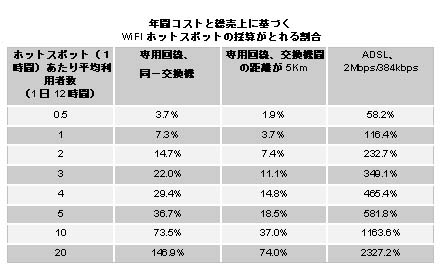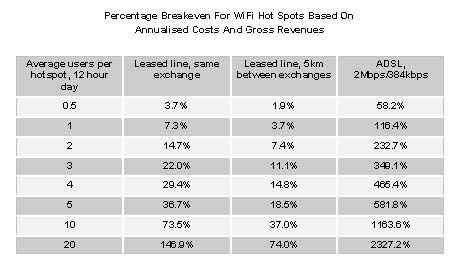| |
 WiFiホットスポットの真相 - 儲かるビジネスなのか? WiFiホットスポットの真相 - 儲かるビジネスなのか?
2003年12月15日号
今月の速報では、ヨーロッパの少し東、マレーシアを見てみる。何の因果で? 我々はある大きなプロジェクトのために数週間現地で調査をしている。ヨーロッパで同様なプロジェクトを行った経験を生かしてのことである。
ここで取り組んでいることと関わりはないが、我々はクアラルンプールにおけるWiFi「ホットスポット」の数にずっと興味を持ってきた。特に、ホットスポットの接続コストの安さに注目している。ついては、マレーシアにおけるWiFiホットスポットの経済性について、外観してみることにした。
現在、TMnet(Telecom MalaysiaのISP子会社)が提供するプリペイドのホットスポット接続カードの通常価格(つまり割引価格ではない価格)は、30日間の無制限WiFi接続で19RM(マレーシアリンギット)(543円)である。これは安いように思われたので、ホットスポット開設の見込みコストについて検証してみることにしたのである。
* 機器コスト
* 設定コスト
* 機器のメンテナンス・コスト
* インターネットへの接続コスト、主に伝送コスト
* 地代
* 電気代
* 販売促進のためのコスト
専用回線とxDSLのいずれを利用するかによるが、上記のうちインターネットの接続コストが最も大きく、他のコストは比較的低いように思われる。
そのため、ここでは以下のコストについては考慮していない:
* 電気代。最もコストが低いと思われるため
* 地代。施設の持ち主は、一つまたは複数のWiFiホットスポットについて同施設のメリットとしての付加的な客寄せ要因と見なすだろうと思われるため
接続回線については、次のような事情はあるが、2Mbpsの回線1本を想定してきた:
* MTBF(平均故障間隔)が短いまたはMTTR(平均復旧時間)が長い場合には、「デュアル・ホスト」が必要になるであろう。おそらくは代替的な回線サプライヤ(例としては、1本の回線を移動体事業者から買い付けることが可能であるかもしれない)からのものを利用することになろう。
* 一日のうちに最繁時が存在し、その間に毎日のWiFiユーザー数の釣り合いがとれない場合には、適度な質のサービスを提供するために2本以上の回線が必要になるかもしれない。
下記の表は場所を想定し、1日の利用時間を12時間と仮定して、上記に挙げた種類のホットスポットのコストをカバーするために1時間あたり平均何人のユーザーが必要かを簡単にまとめたものである。売上の25%は小売店の手数料として割り当てたが、サービス提供企業のオーバーヘッドは考慮していない。1日の利用を12時間としたのは次のようなことからである。たいてのホットスポットはカフェやレストランの近くにあり、ユーザーは席についてインターネットに接続することができる。こうした施設は通常、1日最長で12時間の営業時間をもつからである。

上記から、採算性はインターネット接続コストに最も敏感に反応することが分かる。簡単な結論として、以下のようなことが言える:
* 達成可能なユーザー数で採算を取るには、ホットスポットにはxDSL接続が欠かせない。12時間の営業時間のうち、10〜20人のコンピュータ利用者が同一時間帯にカフェ1軒内に見られることがどれくらいあるだろうか? それを考えて見れば分かる。
* ADSL接続があれば、ホットスポットは次のような条件で収益を挙げられる:
o 十分なユーザー数がある
o 短時間の需要に応じるためだけにインターネット接続容量を拡大する必要があるような、バランスのとれない最繁時間が存在しない
o 許容範囲での信頼性に到達するために必要なのは、接続回線1本である
o サービス提供企業のオーバーヘッドや販売促進のためのコストなど、他のコストは低く保たれる
こうした種類の分析を理解することのメリットのひとつは、計りやすいということである。ある会社が10〜20箇所のホットスポットを持つ場合は、必要な平均ユーザー数にホットスポットの数を単純に掛けることになる。しかし、ホットスポットの数が多くなるほど、最繁時のピークや例外的な需要が起こる時間についての問題が出やすくなる。
この大まかな分析を行うにあたり、標準的な企業向けADSL料金表を用いた。しかし、実際には、WiFiユーザーのローミングに必要なダイナミックIPアドレス数を提供するためにもっと高額のレートが適用されるかもしれない。しかし逆に、eメールアドレスやホスティングスペースなどといったインターネットアカウントの機能は何も必要としないであろう。
結論としては、ULL(アンバンドルされたローカルループ)がWiFiホットスポット事業者に大きな市場機会を提供することになろう。ULLはマレーシアでは来年利用可能になる予定である。他の多くの国では既に使われている。
また、価格が適切であり、スループット全体に制限がなければ、固定ブロードバンドからの乗り換えも出てくるだろう。旧来の事業者の交換機にDSLAMを持つISPは、ホットスポットのためにULLのわずかな接続コストを追加するだけなので、特に優位に立つだろう。しかし、インターネット接続に複数の形を提供する事業者は、ホットスポットの料金を他に比べて過度に競争力のある設定にすることで、例えばxDSLサービスや一律料金のISDNサービス、また場合によってはダイアルアップ接続など、他のサービスからの収益を食いつぶすことのないよう、注意を払わなければならない。
より大手のISPがこうした販売促進で自らを締め付けるかどうか定かではないが、大手ISPが、自分のホットスポット開設を願う人を相手に「ホールセール」サービスを提供したくなる可能性はかなり高い。ホットスポット展開を望むカフェなどのチェーンは、量的に十分であればISPの提供する「ホールセール」サービスが、当該カフェのブランドをもってサービスを塗り替えられることさえあるかもしれない。もしISPがそうしたサービスを提供しないとしても、上記の大まかな分析に基づけば特にULLが利用可能になった時点で、おそらくやらざるを得なくなるだろう。
(C) 2003 Telecommunication Ltd.
(原文)
 The Truth About WiFi Hot Spots The Truth About WiFi Hot Spots
Can they make money?
Dec.15, 2003
For this month's bulleting we look a little East of Europe - to Malaysia. What is the connection? We have been working here for some weeks on a major project, drawing on our experience of similar projects in Europe.
Although not connected with what we are working on, we have been interested in the number of WiFi 'Hot Spots' in Kuala Lumpur. In particular, we have been intrigued by the low cost of Hot Spot access. Consequently, we thought we would take a brief look at the economics of WiFi Hot Spots in Malaysia.
Currently the regular price (that is, not a promotional price) for a TMnet (Telecom Malaysia's ISP subsidiary) prepaid Hot Spot access card is RM19 (JPY 543) for 30 days unlimited WiFi access. This seemed inexpensive, so we decided to look into the possible costs of established a Hot Spot.
The costs involved in establishing a Hot Spot are chiefly:
* Equipment costs
* Installation costs
* Equipment maintenance costs
* Internet access costs, mainly the transmission cost
* Landlord's rent
* Electricity
* Marketing costs.
Of the above, the Internet access cost is potentially the most expensive -- depending on whether leased lines or xDSL is used -- making the other costs seem comparatively low.
For the purpose of this exercise, we have ignored the following costs:
* Electricity costs, as they are likely to be the smallest element
* Landlord's rent, as we have assumed that landlord's will see the added attraction of one or more WiFi Hot Spot as a benefit for the property.
For the access lines, we have assumed a single 2Mbps circuit, although:
* Where MTBFs (mean time between failures) are short and/or MTTRs (mean times to repair) are long, then 'dual hosting' is probably required, perhaps using alternative circuit suppliers (for instance, it might be possible to buy one circuit from a mobile operator)
* If there are busy periods during the day with a disproportionate number of the daily WiFi users being there during that period, then more than one circuit might be necessary to provide a reasonable quality of service.
Having set the scene, the table below provides a simplistic view of the average number of users per hour necessary in order for a Hot spot to cover the cost categories identified above, assuming a 12 hour day. No allowance has been made for corporate contributions, although 25% of the sale price has been allowed for the retailer's margin or commission. A 12 hour day has been assumed because most Hot Spots are located near cafes and restaurants, so users can sit while they access the Internet, and these typically have a maximum of a twelve hour operating day.

From the above it can be seen that the key sensitivity is the Internet access cost. The simple conclusions are that:
* Without xDSL access, Hot Spots cannot break even with achievable numbers of users. Consider how often you have seen a caf・ with 10 to 20 potential computer users every hour of a 12 hour day
* With ADSL access, Hot Spots can be profitable provided:
o there are enough users
o there are not disproportionate busy hours, requiring greater Internet access capacity just to meet the demands for this short period
o a single access circuit is all that is necessary to achieve acceptable reliability, and
o other costs, such as corporate contributions and marketing costs are kept low.
One of the benefits of undertaking this type of analysis is that it is scalable. If a business had 10 or 20 Hot Spots, one would simply multiply the average number of users needed by the number of Hot Spots. However, the more Hot Spots are involved, the more likely problems of busy hour peaks or other periods of exceptional demand become.
In undertaking this cursory analysis, we have used standard business ADSL tariffs. However, in practice, higher rates may apply in order to provide the number of dynamic IP addresses required for roaming WiFi users. Conversely, though, no Internet account features such as email addresses, hosting space, etc, will be required.
This leads us to the conclusion that unbundled local loop (ULL), due next year in Malaysia and available already in many countries, will create great opportunities for WiFi Hot Spot operators.
And if the pricing is right and total throughput is unlimited, then migration from fixed broadband delivery may occur. ISPs with DSLAMs in the incumbent operators' exchanges will be particularly well placed, as Hot Spots can be added at ULL marginal access cost. Operators offering multiple forms of Internet access will have to be careful, though, not to cannibalize other service revenues by positioning Hot Spot tariffs too competitively against, for instance, xDSL services, flat-top ISDN services -- and possibly even dial-up access.
Whether the larger ISPs could be bothered with such initiatives themselves is unclear, but it is highly likely that they will want to offer a 'wholesale' service to anyone wishing to establish their own Hot Spot. For chains wishing to deploy hotspots, for instance caf・ chains, if the volumes are sufficient the ISPs offering the 'wholesale' service may even re-brand the service with the brand of the caf・. And if ISPs don't offer such services, especially when ULL is available, based on our cursory analysis above, then probably they should
(C) 2003 Telecommunication Ltd.
トニー・デンチのユーロレポートのバックナンバーはこちらから
|
|

 WiFiホットスポットの真相 - 儲かるビジネスなのか?
WiFiホットスポットの真相 - 儲かるビジネスなのか?